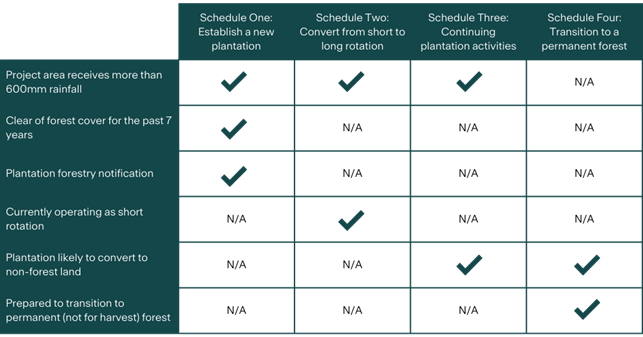Let’s break down the basics of a plantation forestry carbon project.
What is a Plantation Forestry Carbon Project?
At CFF we help landowners register and manage plantation forestry carbon projects. Projects are typically run under the ACCU Scheme’s Plantation forestry methodology (AKA the method). A plantation project aims to accumulate or sequester carbon as trees are grown and managed within a plantation across a 25-year project crediting period. This includes the carbon stored in trees as well as the debris and harvested wood products. By building up carbon stocks within the plantation and its products, you are removing carbon from the atmosphere. This removal – and subsequent increase in your carbon stocks – earns you carbon credits.
What are the different ways to earn carbon credits?
Under the method, there are four different practices that enable you to earn carbon credits. You can:
- Establish a new plantation,
- Convert an existing plantation from short to long rotation,
- Continue plantation activities on land that would otherwise convert to a viable, non-forested use, or
- Transition your plantation to a permanent forest.
Each of these management approaches has its own ‘schedule’ in the method, which lays out the detail of eligibility requirements.
I’m struggling to wrap my head around the method… can you explain whether my operation is eligible to start a plantation project?
As there are four different ways to run a plantation project, we’ve provided high-level eligibility information for each via a simple table. We’ll explore this in more detail for you as part of our feasibility assessment.


Awesome, I think I’m eligible. Will my project turn a profit?
Great question! ! Assuming all else is the same, there are two key profit drivers for plantation projects:
- Project scale
- FullCAM modelled carbon yield
1. Project Scale
If you’re keen to turn a profit, you do need to consider scale in order to ensure you cover your compliance costs and generate a positive return. There are no hard and fast rules, but unless you have a pretty staggering modelled carbon yield at your plantation, then a project under 100 hectares is not likely to pay its own bills. Remember, if you have multiple smaller plantations, you can aggregate them together into one project.
2. FullCAM Modelled Carbon Yield
Let us introduce you to the CFF FullCAM heatmaps handy blog post which outlines everything you need to know. Yes, the blog focuses on FullCAM in the context of permanent native tree plantings, not commercial plantations. And yes, the carbon abatement curve in plantation projects looks a little different as it considers harvest and thinning events, but otherwise, the carbon yield modelling principles are the same. Read on for how we can help you work out the yield at your place.
Ok, how do I get started?
It’s as easy as 1, 2, 3.
- Read the above, and if you think you’ve got a project on your hands, get in touch with the CFF team with your operation’s address, hectares, species, rotation and ideally a shapefile with your plantings or planned plantings mapped out for us.
- We’ll sense check your eligibility, and we’ll either quote you our rate to work out the indicative FullCAM yield for your plots or suggest you go straight through to the feasibility stage. For either option, the simpler your plans, the cheaper our quote will be.
- Once we have your go-ahead, we’ll model the project, share the results in a feasibility presentation, and get you moving towards carbon project lift-off!
Ready to find out more?
Explore our range of educational resources in our Carbon Farming Education Hub where we frequently publish educational articles, webinars, and guidebooks.
When you’re ready to explore the feasibility of undertaking a carbon project on your property, email us at [email protected] or give us a bell at (08) 6835 1140 to be connected with one of our project facilitators.


![AFN – Cert Accredited Expert [RGB] AFN - Cert Accredited Expert [RGB]](https://carbonfarming.org.au/wp-content/uploads/elementor/thumbs/AFN-Cert-Accredited-Expert-RGB-e1725255016744-qti2uogw4b9a3s6au2d1bbf4utb8ggjuwvkj4qpce8.png)